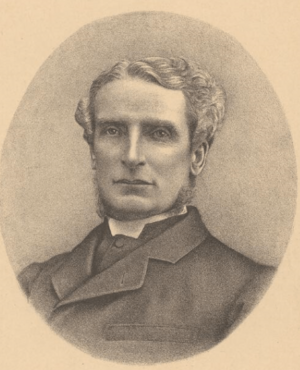George William Torrance facts for kids
Quick facts for kids
Rev. George William Torrance
|
|
|---|---|

George Torrance Mus. Doc.
|
|
| Background information | |
| Born | 25 June 1835 Rathmines, Dublin, Ireland |
| Died | 27 August 1907 (aged 72) |
| Occupation(s) | Composer, Conductor, Minister |
| Years active | 1869-1898 |
George William Torrance (born June 25, 1835 – died August 20, 1907) was an Irish composer. He mostly wrote music for churches. He lived in Australia for many years.
Contents
Early Life and Musical Start
George Torrance was born in Rathmines, a part of Dublin, Ireland. When he was young, he sang in the choir at Christ Church Cathedral from 1847 to 1851.
Even before he turned 20, George was already working as an organist in churches around Dublin. He also wrote his first big musical piece, an oratorio called Abraham, in 1855. An oratorio is like a play told through music, usually with a religious story.
He went to Germany to study music in Leipzig from 1856 to 1857. After that, he studied at Trinity College, Dublin. He earned several degrees there, including a Bachelor of Arts (B.A.) in 1864 and a Master of Arts (M.A.) in 1867. Later, in 1879, he also earned advanced music degrees (MusB and MusD).
Before becoming a clergyman, George also tried writing other kinds of music. He composed an opera called William of Normandy in 1858. An opera is a play where all the words are sung. He also wrote several songs. In 1865, he became a priest for the Church of England. He worked in churches in England and Ireland before moving to Australia.
Life and Music in Australia (1869–1898)
George Torrance moved to Victoria (Australia) in December 1869. Soon after, he started working as a priest at Christ Church in South Yarra. From 1871 to 1876, he was in charge of St. John's Church in Melbourne.
In 1872, he became the Acting Head of Trinity College (University of Melbourne) when it first opened. He later moved to lead All Saints' Church in Geelong in 1877. The next year, he was appointed to Holy Trinity Church in Balaclava. When he received his music degrees from Trinity College Dublin in 1879, the University of Melbourne also recognized them.
George was very involved in music in Australia. In 1880, he became the President of the Fine Arts section at a big meeting called the Social Science Congress. He also worked with a person named Alfred William Howitt. They wrote down three songs that were sung by William Barak. William Barak was an important elder of the Wurundjeri-willam people.
One of George's most famous works was his oratorio The Revelation, which he wrote in 1882. This piece was performed at the Melbourne Town Hall, and George himself conducted it.
In 1883, George was chosen as an examiner for a scholarship at the Royal College of Music in London. He also helped judge a competition for a special song for the Centennial Exhibition in 1880.
In 1886, George visited Europe. He went to the famous Wagner Festival in Bayreuth, Germany. This festival celebrates the music of a famous composer named Wagner. George brought a young Australian musician named Ernest Hutcheson with him. George Torrance married the eldest daughter of S. B. Vaughan, a lawyer from Melbourne, in 1872.
Returning to Ireland
George Torrance and his wife moved back to Ireland in 1898. He became a chaplain to the bishop of Ossory. He also worked at St Canice's Cathedral in Kilkenny.
In 1899, his oratorio The Revelation was performed again in London. He started composing music again, writing more church services and songs. In 1900, he was appointed a canon, which is a special role for a priest.
George Torrance passed away in Kilkenny, Ireland, on August 20, 1907. A music expert named Johnstone said that George Torrance was "arguably the most accomplished Irish church musician of his generation" after another composer, Robert Prescott Stewart. This means he was one of the best Irish church musicians of his time.
Recognition and Legacy
A special memorial tablet was put up to remember George Torrance. It was made by J. R. Tranthim-Fryer. The tablet was unveiled at Trinity College, Melbourne in June 1908.
Selected Musical Works
George Torrance wrote many different types of music. Here are some of his important compositions:
Operas
- William of Normandy (1858) - This was an opera with two acts.
Oratorios
- Abraham (1855) - His first oratorio.
- The Captivity (1864) - Based on a work by Oliver Goldsmith.
- The Revelation, or Vision of St. John in the Isle of Patmos (1882) - A well-known oratorio based on the Bible.
Church Music
- Festival Service, Cantate Domino, Deus misereatur (1881)
- And the Lord Said (1888) and other anthems (published between 1881 and 1902)
- Magnificat and nunc dimittis in A major (1889)
- Magnificat and nunc dimittis in F major (1906)
- Magnificat and nunc dimittis in D major (1906)
- Sacred Songs (1885) - He edited works by Handel and Mendelssohn for voice and piano.
Other Vocal Music
- My Native Land (1857) - A song.
- The Bride (1857) - Another song.
- Songs of Faith and Hope (1889) - For voice and piano, with parts for flute, violin, and cello.
- A Welcome to the Queen in Ireland (1901) - A song.
- Dry be that Tear (1904) - A partsong.
- A Dream within a Dream (1904) - A partsong based on a poem by Edgar Allan Poe.
- The Land Beyond the Sea
- A Matin Song

